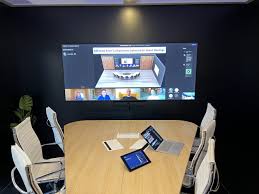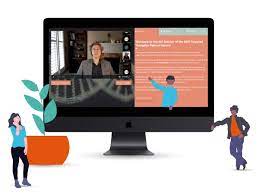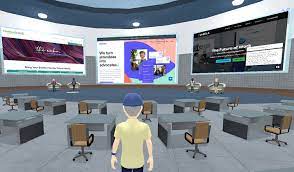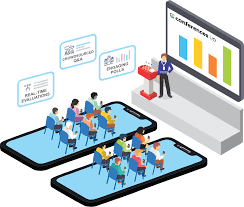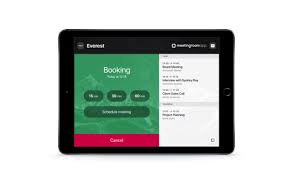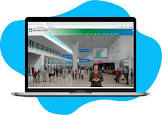Audience Engagement Platforms: Enhancing Interaction and Connection
In today’s digital age, audience engagement has become a key focus for businesses and organizations across various industries. Captivating and connecting with your audience is crucial for building brand loyalty, fostering meaningful interactions, and ultimately driving success. To achieve this, many companies are turning to audience engagement platforms as a powerful tool in their marketing arsenal.
So, what exactly are audience engagement platforms? Simply put, these platforms are software solutions designed to facilitate interaction between businesses and their target audiences. They provide a range of features and functionalities that enable organizations to engage with their audience in innovative ways.
One of the primary benefits of using an audience engagement platform is the ability to create interactive experiences. These platforms offer tools such as live polls, surveys, quizzes, and gamification elements that encourage active participation from attendees or customers. By incorporating these interactive elements into your events or marketing campaigns, you can capture your audience’s attention and make them feel involved in the process.
Moreover, audience engagement platforms often include robust analytics capabilities. These features allow you to gather valuable data on attendee behavior, preferences, and interests. By analyzing this data, you can gain insights into your audience’s needs and tailor your future strategies accordingly. This data-driven approach enables businesses to create personalized experiences that resonate with their target demographic.
Another advantage of utilizing an audience engagement platform is its versatility across different channels. Whether it’s a live event, webinar, social media campaign, or even an online community forum, these platforms can be adapted to suit various communication channels. This flexibility ensures that you can engage with your audience wherever they are most active.
Furthermore, some advanced platforms offer real-time communication features like chatbots or live chat support. These tools enable immediate interaction between businesses and their audiences by providing instant responses to queries or concerns. Such prompt communication not only strengthens the connection but also enhances customer satisfaction levels.
Additionally, many audience engagement platforms integrate seamlessly with existing marketing and customer relationship management (CRM) systems. This integration allows for streamlined data management, ensuring that all interactions and engagement metrics are captured in one centralized location. This holistic approach provides a comprehensive view of your audience’s journey and enables you to refine your engagement strategies based on accurate insights.
In conclusion, audience engagement platforms have revolutionized the way businesses interact with their target audiences. By leveraging interactive features, gathering valuable data, and offering real-time communication channels, these platforms empower organizations to create memorable experiences that foster long-term connections. Whether it’s through live events, virtual conferences, or digital marketing campaigns, audience engagement platforms are essential tools for businesses looking to captivate their audience and drive success in today’s competitive landscape.
9 Pros of Audience Engagement Platforms: Enhancing Visibility, Customer Experience, Brand Awareness, and More
- Increased visibility
- Improved customer experience
- Increased brand awareness
- Faster feedback loops
- Better analytics capabilities
- Easier collaboration
- Improved communication channels
- Automation of processes
- Cost savings
Drawbacks of Audience Engagement Platforms: Exploring Cost, Time, Reach, Privacy Concerns, and Customization Limitations
- Cost
- Time
- Limited Reach
- Privacy Concerns
- Lack of Customization
Increased visibility
Increased visibility: Audience engagement platforms make it easier for companies to reach a larger, more diverse audience.
In the digital era, expanding your reach and capturing the attention of a wider audience is crucial for business growth. This is where audience engagement platforms come into play, offering a valuable advantage by increasing visibility in today’s crowded marketplace.
Traditionally, businesses relied on traditional marketing channels such as print media or television advertisements to reach their target audience. While these methods still hold some value, they often have limitations in terms of cost and targeting capabilities. However, with the advent of audience engagement platforms, companies now have access to powerful tools that can significantly enhance their visibility.
One of the key benefits of using an audience engagement platform is the ability to leverage various digital channels. These platforms enable businesses to tap into social media networks, websites, mobile apps, and other online platforms where their target audience spends a significant amount of time. By utilizing these channels effectively, companies can extend their reach far beyond traditional boundaries and connect with a larger and more diverse demographic.
Moreover, audience engagement platforms offer features that encourage content sharing and viral marketing. For example, interactive polls or quizzes can be easily shared on social media platforms, generating organic buzz and attracting new audiences who may not have been previously aware of the company or its offerings. This increased visibility through social sharing can lead to exponential growth in brand exposure and recognition.
Additionally, many audience engagement platforms incorporate search engine optimization (SEO) strategies into their functionalities. By optimizing content for search engines, businesses can improve their rankings in search results and increase their chances of being discovered by potential customers who are actively searching for relevant products or services. This enhanced visibility in search engine results pages can drive organic traffic to a company’s website or digital presence.
Furthermore, audience engagement platforms often provide robust analytics tools that allow businesses to track the effectiveness of their marketing campaigns across different channels. These insights help companies understand which strategies are resonating with their audience and which ones need adjustment. By continuously refining their approach based on data-driven insights, businesses can optimize their visibility and target their marketing efforts more effectively.
In conclusion, audience engagement platforms offer a significant advantage to businesses by increasing their visibility in the digital landscape. By leveraging various digital channels, encouraging content sharing, optimizing for search engines, and utilizing analytics tools, companies can expand their reach and connect with a larger, more diverse audience. This increased visibility not only drives brand exposure but also opens up new opportunities for growth and success in today’s competitive market.
Improved customer experience
Improved customer experience: Audience engagement platforms provide customers with an interactive and personalized experience that can improve customer satisfaction and loyalty.
In today’s highly competitive business landscape, providing an exceptional customer experience is paramount. Audience engagement platforms play a crucial role in enhancing the overall customer journey by offering interactive and personalized experiences.
By leveraging the features and functionalities of these platforms, businesses can create engaging interactions with their customers. Through live polls, surveys, quizzes, and gamification elements, customers are actively involved in the process. This level of interactivity not only captures their attention but also makes them feel valued and included.
Moreover, audience engagement platforms enable businesses to gather valuable data about customer preferences, behaviors, and interests. By analyzing this data, companies can gain insights into individual customer needs and tailor their offerings accordingly. This personalization creates a sense of being understood by the brand, fostering a deeper connection between the customer and the business.
The ability to provide real-time communication through chatbots or live chat support further enhances the customer experience. Customers can receive immediate responses to their queries or concerns, eliminating frustration and ensuring a smooth interaction. This prompt communication shows that the business values its customers’ time and is committed to providing excellent service.
By offering an interactive and personalized experience through audience engagement platforms, businesses can significantly improve customer satisfaction levels. Satisfied customers are more likely to become loyal advocates for the brand, spreading positive word-of-mouth recommendations and increasing customer retention rates.
In conclusion, audience engagement platforms have revolutionized the way businesses interact with their customers by focusing on improving their overall experience. Through interactivity, personalization, and real-time communication capabilities, these platforms foster stronger connections between businesses and their customers. By prioritizing enhanced customer experiences through audience engagement platforms, companies can build loyalty among their clientele while staying ahead in today’s competitive market.
Increased brand awareness
Increased brand awareness: An audience engagement platform can be a game-changer when it comes to spreading the word about your brand, products, and services. In today’s crowded marketplace, it’s crucial to stand out and make a lasting impression on potential customers and partners. This is where an audience engagement platform can truly shine.
By utilizing interactive features and engaging content, these platforms create opportunities for your brand to be noticed and remembered. Whether it’s through live polls, quizzes, or interactive presentations, you can capture the attention of your target audience and leave a lasting impact.
Moreover, audience engagement platforms often offer social sharing capabilities. This means that attendees or participants can easily share their experiences with their own networks on social media platforms. By encouraging this organic sharing of content, you exponentially increase your brand’s reach and visibility.
When people engage with your brand through an audience engagement platform, they are more likely to remember and talk about it in their circles. This word-of-mouth marketing is incredibly powerful as it builds trust and credibility for your brand. It also opens doors to new opportunities by attracting potential customers who may have otherwise been unaware of your products or services.
Furthermore, an audience engagement platform allows you to showcase your expertise and thought leadership in your industry. Through webinars, live presentations, or Q&A sessions, you can position yourself as an authority figure in the minds of your target audience. As people engage with your content and perceive you as knowledgeable and trustworthy, they are more likely to consider your brand when making purchasing decisions.
In summary, using an audience engagement platform is a strategic way to increase brand awareness. By leveraging interactive features, encouraging social sharing, and showcasing expertise in your industry, you can effectively spread the word about your brand to potential customers and partners. In today’s competitive landscape where attention spans are short-lived, standing out from the crowd is essential – and an audience engagement platform can be just the tool you need to achieve that.
Faster feedback loops
Faster Feedback Loops: Accelerating Customer-Centric Innovation with Audience Engagement Platforms
In the fast-paced world of business, staying ahead of customer needs is essential for success. This is where audience engagement platforms prove to be invaluable. One significant advantage of these platforms is their ability to provide faster feedback loops, enabling companies to swiftly identify customer needs and respond with new products or services.
Traditionally, gathering feedback from customers was a time-consuming process. Companies relied on surveys, focus groups, or market research studies that could take weeks or even months to yield actionable insights. However, with audience engagement platforms, this process has been revolutionized.
By leveraging real-time data from these platforms, companies can capture immediate feedback from their target audience. Whether it’s through live polls, interactive surveys, or social media engagement features, businesses can gather valuable insights in a matter of seconds or minutes. This accelerated feedback loop allows companies to stay agile and responsive in meeting customer demands.
With the aid of audience engagement platforms, businesses can quickly identify emerging trends and preferences among their audience. By analyzing the data collected in real-time, organizations gain a deeper understanding of what their customers truly want and need. Armed with this knowledge, they can make informed decisions about developing new products or services that align with customer expectations.
Moreover, these platforms enable companies to test ideas and prototypes more efficiently. By engaging directly with their target audience through interactive features like virtual demos or beta testing programs, businesses can gather immediate feedback on product concepts before investing significant time and resources into development. This iterative approach saves valuable time and minimizes the risk of launching products that do not resonate with customers.
The speed at which audience engagement platforms provide feedback also allows businesses to be more proactive in addressing customer concerns or issues. Through real-time communication channels such as chatbots or live chat support integrated into these platforms, companies can promptly respond to customer queries or resolve problems as they arise. This level of responsiveness enhances customer satisfaction and strengthens brand loyalty.
In conclusion, audience engagement platforms offer a game-changing advantage: faster feedback loops. By leveraging real-time data and immediate interactions with their target audience, companies can swiftly identify customer needs, stay ahead of emerging trends, and respond with new products or services. This accelerated feedback loop enables businesses to be more customer-centric, innovative, and responsive in an ever-evolving market landscape.
Better analytics capabilities
Better analytics capabilities: Unleashing the Power of Data with Audience Engagement Platforms
In the digital era, data is king. Businesses are constantly seeking ways to gain deeper insights into their target markets, understand customer behavior, and optimize their strategies accordingly. This is where audience engagement platforms come into play, offering a pro that can revolutionize the way businesses harness data – better analytics capabilities.
Audience engagement platforms provide businesses with powerful tools to gather detailed insights into user behavior. By leveraging features such as surveys, polls, and interactive elements, these platforms enable organizations to collect valuable data on customer preferences, interests, and opinions. This rich pool of information serves as a goldmine for businesses aiming to better understand their target markets.
With better analytics capabilities, businesses can gain a comprehensive view of their audience’s journey. They can track engagement levels during events or campaigns, measure response rates to specific content or promotions, and identify patterns or trends in user behavior. Armed with this knowledge, organizations can make data-driven decisions and optimize their strategies accordingly.
By analyzing the gathered data, businesses can uncover valuable insights that may have otherwise remained hidden. They can identify which aspects of their offerings resonate most with their audience and tailor future campaigns or product developments accordingly. For example, if an organization discovers through analytics that a certain demographic responds positively to a particular type of content or interactive feature, they can focus more resources on creating similar experiences in the future.
Moreover, audience engagement platforms often offer real-time analytics dashboards that provide instant access to key metrics and performance indicators. This enables businesses to monitor the success of their engagement efforts in real-time and make adjustments on the fly if necessary. Whether it’s tracking attendee participation rates during a live event or monitoring click-through rates on a digital marketing campaign, these platforms empower organizations with up-to-the-minute insights.
Better analytics capabilities also allow for more accurate measurement of return on investment (ROI). By understanding how various engagement strategies impact customer behavior and conversion rates, businesses can assess the effectiveness of their marketing efforts and allocate resources more efficiently. This data-driven approach helps optimize marketing budgets, ensuring maximum impact and ROI.
In conclusion, audience engagement platforms offer businesses a powerful advantage – better analytics capabilities. By harnessing the power of data, organizations can gain deeper insights into their target markets, understand customer behavior, and optimize their strategies accordingly. With access to detailed analytics and real-time metrics, businesses can make informed decisions, create personalized experiences, and drive success in today’s competitive landscape.
Easier collaboration
Easier Collaboration: Unlocking the Power of Teamwork with Audience Engagement Platforms
In today’s fast-paced business environment, collaboration is the key to success. Teams need to work together seamlessly, sharing ideas, content, and resources in real time. This is where audience engagement platforms shine, providing a centralized hub for collaboration that enhances productivity and fosters creativity.
One of the significant advantages of using audience engagement platforms is their ability to facilitate easier collaboration among teams. These platforms offer a range of tools and features that enable teams to share ideas and work together effectively. By providing a centralized space for communication and file sharing, these platforms eliminate the need for multiple disjointed communication channels and ensure that everyone is on the same page.
With audience engagement platforms, teams can collaborate in real time, regardless of their physical location. Whether team members are working remotely or in different offices across the globe, these platforms bridge the distance and allow for seamless collaboration. This real-time aspect enhances efficiency by eliminating delays associated with waiting for emails or scheduling meetings.
Moreover, audience engagement platforms provide a secure environment for sharing sensitive information within teams. They offer robust access controls and permissions settings that ensure only authorized individuals have access to specific documents or discussions. This level of security gives teams peace of mind when collaborating on confidential projects or sharing proprietary information.
Another valuable feature of these platforms is their ability to capture and store all collaborative efforts in one place. Instead of searching through countless email threads or shared drives for important files or discussions, team members can easily retrieve information from the platform’s organized structure. This saves time and effort while promoting transparency within the team.
Furthermore, audience engagement platforms often integrate with other productivity tools commonly used by teams such as project management software or document editors. This integration streamlines workflows by allowing seamless transfer of data between different applications. It eliminates the need for manual data entry or switching between various tools, ensuring a smooth collaborative experience.
In conclusion, audience engagement platforms offer a game-changing advantage in terms of team collaboration. By providing a centralized space for sharing ideas, content, and resources in real time, these platforms enhance productivity and foster creativity. With features like secure file sharing, real-time communication, and integration with other productivity tools, teams can work together seamlessly regardless of their physical location. Embracing audience engagement platforms unlocks the power of teamwork and propels organizations towards greater success in today’s collaborative business landscape.
Improved communication channels
Improved Communication Channels: Strengthening Connections with Audience Engagement Platforms
In the fast-paced digital world we live in, effective communication is key to building strong relationships with customers. Audience engagement platforms have emerged as a game-changer in this regard, offering companies the ability to establish and maintain multiple channels of communication with their audiences. This enhanced connectivity plays a vital role in keeping businesses connected with their customers at all times.
One of the primary advantages of audience engagement platforms is their ability to create diverse communication channels. Companies can now reach out to their audience through various means such as email, SMS, chatbot interactions, social media messaging, and more. This versatility ensures that businesses can connect with their customers using the channel that best suits their preferences and habits.
By offering multiple communication channels, companies can meet their customers where they are most active. Some individuals prefer receiving updates via email, while others may prefer quick interactions through SMS or social media messaging. With audience engagement platforms, businesses can cater to these diverse preferences and ensure that important messages and information are delivered effectively.
Moreover, these platforms enable businesses to maintain a continuous connection with their audiences. Through automated email campaigns or personalized SMS notifications, companies can keep their customers informed about new products or services, upcoming events or promotions, and other relevant updates. This consistent communication helps foster a sense of loyalty and keeps customers engaged with the brand.
The integration of chatbots within audience engagement platforms further enhances communication capabilities. Chatbots provide instant responses to customer queries or concerns 24/7. Customers appreciate quick assistance and appreciate brands that prioritize prompt communication. By utilizing chatbots on websites or social media platforms, businesses can offer immediate support and address customer needs efficiently.
Additionally, audience engagement platforms often include features for social media management. These tools enable companies to schedule posts, monitor comments and messages across various social media platforms from a single interface. This centralized approach streamlines social media interactions and allows for timely responses, ensuring that businesses can maintain an active and engaging presence on social media.
In conclusion, audience engagement platforms have revolutionized communication channels for businesses. By offering a range of options such as email, SMS, chatbots, and social media integration, these platforms empower companies to stay connected with their audiences at all times. This improved connectivity not only strengthens relationships but also enhances customer satisfaction and loyalty. With audience engagement platforms, businesses can effectively communicate their brand message, provide timely support, and keep customers engaged in an increasingly competitive market.
Automation of processes
Unlocking Efficiency: Automation of Processes with Audience Engagement Platforms
In the fast-paced world of business, time and resources are valuable commodities. That’s why one of the standout benefits of audience engagement platforms is their ability to automate various processes, delivering increased efficiency and productivity for businesses.
With an audience engagement platform, businesses can streamline tasks such as lead generation and segmentation. These platforms offer tools that automatically capture leads’ information and categorize them based on their interests and preferences. By automating this process, businesses can save significant time that would otherwise be spent manually sorting through leads. This not only speeds up the lead qualification process but also ensures that relevant marketing efforts are targeted to the right audience segments.
Furthermore, audience engagement platforms enable businesses to automate their marketing campaigns and promotions management. Instead of manually scheduling and sending out emails or social media posts, these platforms offer features that allow for automated campaign workflows. Businesses can set up predefined triggers or actions that initiate a series of targeted messages or promotions based on specific criteria. This automation ensures timely communication with the audience without the need for constant manual intervention.
The automation capabilities of audience engagement platforms not only save time but also enhance efficiency. By eliminating repetitive manual tasks, businesses can redirect their focus towards more strategic activities such as analyzing data, refining strategies, and nurturing customer relationships. This shift in focus allows for better resource allocation and empowers teams to work on high-value initiatives that drive growth.
Moreover, automation reduces the risk of human error. Manual processes are prone to mistakes, which can have a negative impact on customer experiences or lead to missed opportunities. Audience engagement platforms provide a reliable framework where processes are executed consistently and accurately. From capturing leads to managing campaigns, automation ensures a seamless flow of operations while maintaining data integrity.
Additionally, by automating processes through an audience engagement platform, businesses gain valuable insights into performance metrics. These platforms often provide analytics dashboards that track key metrics related to lead generation, campaign engagement, and conversions. This data allows businesses to measure the effectiveness of their strategies, identify areas for improvement, and make data-driven decisions to optimize future campaigns.
In conclusion, the automation of processes offered by audience engagement platforms is a game-changer for businesses. By automating lead generation, segmentation, marketing campaigns, and promotions management, these platforms save time and resources while increasing efficiency. The ability to focus on strategic initiatives, reduce human error risks, and gain valuable insights through analytics makes automation a powerful tool in driving business growth. Embracing audience engagement platforms with automation capabilities can unlock new levels of productivity and success in today’s competitive landscape.
Cost savings
Cost Savings: The Financial Advantage of Audience Engagement Platforms
In the realm of marketing, every business aims to maximize results while minimizing costs. One significant advantage of audience engagement platforms is their ability to provide cost savings compared to traditional methods such as print ads or direct mailers.
By leveraging an audience engagement platform, businesses can reduce their reliance on expensive print materials and postage fees. Instead of investing in physical collateral, companies can utilize digital tools within the platform to engage with their target audience. This shift not only saves money but also aligns with the growing preference for digital interactions among consumers.
Moreover, audience engagement platforms offer a range of cost-effective features that deliver desired results without breaking the bank. For instance, instead of spending a substantial amount on organizing physical events or trade shows, businesses can opt for virtual events hosted through the platform. Virtual events eliminate venue rental costs, travel expenses, and other logistical expenditures associated with in-person gatherings.
Additionally, audience engagement platforms often provide analytics and reporting functionalities that enable businesses to track their return on investment (ROI) more effectively. By monitoring engagement metrics and analyzing data collected through the platform, companies can gain insights into the effectiveness of their marketing efforts. This data-driven approach allows for better decision-making and optimization of future campaigns, ultimately leading to improved cost-efficiency.
Furthermore, audience engagement platforms offer scalability options that accommodate businesses of all sizes. Whether you’re a small startup or a large enterprise, these platforms typically provide tiered pricing plans that align with your specific needs and budget constraints. This scalability ensures that you only pay for the features and services you require while still achieving your desired results.
In summary, utilizing an audience engagement platform offers significant cost savings for businesses compared to traditional marketing methods. By eliminating print costs, reducing reliance on physical collateral, and opting for virtual events or digital interactions, companies can achieve desired outcomes while keeping expenses in check. Furthermore, the analytics capabilities provided by these platforms enable businesses to make data-driven decisions, optimizing their marketing strategies for better cost-efficiency. Embracing audience engagement platforms not only enhances customer engagement but also delivers a financial advantage in today’s competitive business landscape.
Cost
Cost: A Consideration When Choosing Audience Engagement Platforms
While audience engagement platforms offer a multitude of benefits, it’s important to acknowledge that they may come with a con that can be a significant factor for some businesses: cost. Implementing and utilizing these platforms can be expensive, making them potentially prohibitive for organizations operating on tighter budgets.
The cost of audience engagement platforms can vary depending on several factors, including the size and scale of your business, the features and functionalities you require, and the duration of your engagement campaigns or events. These platforms often involve subscription fees or licensing costs, which can add up over time.
For smaller businesses or startups with limited financial resources, investing in an audience engagement platform may not be feasible or justifiable at certain stages. The upfront expenses associated with these platforms might strain budgets that are already stretched thin.
It’s crucial for businesses to carefully evaluate their specific needs and weigh the potential return on investment (ROI) before committing to an audience engagement platform. Conducting a cost-benefit analysis can help determine if the expected benefits and outcomes outweigh the financial implications.
However, it’s worth noting that while some audience engagement platforms may have high price tags, there are also more affordable alternatives available. It’s important to research different providers, compare pricing models, and consider what features are truly essential for your business objectives. Some platforms even offer tiered pricing plans or customizable options that allow you to select only the functionalities you require.
Moreover, it’s essential to consider the long-term value that audience engagement platforms can bring. By enhancing customer interactions and fostering loyalty, these platforms have the potential to generate increased revenue and drive business growth. Therefore, it’s crucial to assess not only immediate costs but also the potential returns over time.
In conclusion, cost is indeed a con when considering audience engagement platforms. However, it shouldn’t discourage businesses from exploring these solutions altogether. By conducting thorough research and evaluating both short-term expenses and long-term benefits, organizations can make informed decisions about whether investing in an audience engagement platform aligns with their budgetary constraints and overall business goals.
Time
Time: The Learning Curve of Audience Engagement Platforms
While audience engagement platforms offer numerous benefits, it’s important to acknowledge that there can be a con associated with their implementation – the learning curve. Effectively utilizing an audience engagement platform often requires a significant investment of time and effort to understand its functionalities and maximize its potential.
Learning how to use an audience engagement platform effectively involves familiarizing oneself with its features, understanding the various tools available, and exploring the platform’s capabilities. This process may involve training sessions, tutorials, or even trial and error experimentation. For individuals or teams who are already stretched thin with other responsibilities, dedicating sufficient time to learn a new platform can be challenging.
Moreover, as technology evolves rapidly, audience engagement platforms continually introduce new features and updates. Keeping up with these changes requires ongoing education and adaptation. Staying abreast of the latest functionalities ensures that you are making the most of the platform’s capabilities and staying competitive in engaging your target audience effectively.
However, it’s important to note that this learning curve is not insurmountable. Many audience engagement platforms provide comprehensive documentation, support resources, and even customer service assistance to help users navigate their way through the platform’s intricacies. Additionally, some platforms offer user-friendly interfaces that simplify the learning process for beginners.
To mitigate this con effectively, organizations can allocate dedicated time for training or assign a team member responsible for mastering the platform and sharing their knowledge with others. By investing in proper training and ongoing education on the platform’s usage, businesses can ensure that they leverage its full potential without sacrificing excessive time or productivity.
It is also worth considering that once users become proficient in using an audience engagement platform efficiently, they will likely experience increased productivity in planning and executing engaging experiences for their audiences. The initial investment of time spent learning will eventually pay off as businesses reap the rewards of enhanced audience interactions and strengthened connections.
In conclusion, while there may be a learning curve associated with audience engagement platforms, the benefits they offer often outweigh the time investment required. By dedicating time and resources to understand and master these platforms, businesses can unlock their full potential and create engaging experiences that captivate their target audience. With proper training and ongoing education, organizations can navigate this con effectively and harness the power of audience engagement platforms to drive success.
Limited Reach
Limited Reach: Platforms may limit the reach of your content or messages, depending on the platform’s size or user base.
While audience engagement platforms offer numerous benefits, it’s important to consider potential drawbacks as well. One significant con is the limited reach that these platforms may impose on your content or messages, depending on their size or user base.
Not all audience engagement platforms are created equal in terms of their reach and user demographics. Some platforms may have a smaller user base, which means that your content or messages might not reach as many people as you would like. This can be especially challenging if you’re trying to target a specific niche or industry.
Moreover, certain platforms may have limitations in terms of geographical reach. If your target audience is spread across different regions or countries, it’s crucial to ensure that the platform you choose has a substantial presence in those areas. Otherwise, you risk missing out on potential engagement opportunities and connecting with a wider audience.
It’s also worth considering that some audience engagement platforms have algorithms that prioritize certain types of content over others. This can affect the visibility of your messages, particularly if they are not deemed as highly engaging by the platform’s algorithm. As a result, even if you invest time and effort into creating compelling content, it may not receive the desired exposure due to these limitations.
To mitigate this con, it is essential to conduct thorough research and select an audience engagement platform that aligns with your target audience and goals. Consider factors such as platform size, user demographics, geographical coverage, and algorithmic preferences before making a decision. By choosing a platform with a broad reach and an active user base relevant to your industry or niche, you can maximize the potential impact of your content.
Additionally, diversifying your approach by utilizing multiple channels for audience engagement can help overcome this limitation. Combining different platforms and strategies allows you to expand your reach beyond any single platform’s constraints and ensures that your message reaches a wider audience.
In conclusion, while audience engagement platforms offer valuable features and functionalities, it’s crucial to be aware of the potential limitation of limited reach. By carefully selecting the right platform and diversifying your approach, you can mitigate this con and ensure that your content or messages reach the widest possible audience, maximizing engagement and achieving your desired outcomes.
Privacy Concerns
Privacy Concerns: Safeguarding Personal Information in Audience Engagement Platforms
As businesses increasingly embrace audience engagement platforms, it is essential to address a potential downside: privacy concerns. While these platforms offer numerous benefits, they often require users to provide personal information, raising valid apprehensions if not handled properly.
When using audience engagement platforms, individuals may be prompted to share their names, email addresses, or other personally identifiable information. While this data is necessary for businesses to personalize experiences and tailor content, it also raises concerns about how this information is collected, stored, and used.
To mitigate privacy risks, it is crucial for organizations to prioritize data protection and implement robust security measures. This includes employing encryption protocols to safeguard sensitive information and ensuring compliance with relevant data privacy regulations such as GDPR or CCPA.
Transparency is another key aspect in addressing privacy concerns. Businesses should clearly communicate how user data will be collected, stored, and utilized. This transparency fosters trust between organizations and their audiences by providing individuals with a clear understanding of how their personal information will be handled.
Moreover, obtaining explicit consent from users before collecting their personal data is essential. Implementing opt-in mechanisms ensures that individuals have control over the information they share and gives them the opportunity to make informed decisions about their privacy.
Regularly reviewing and updating privacy policies is also crucial. As technology evolves and new threats emerge, organizations must remain vigilant in adapting their practices to protect user data effectively. By staying up-to-date with the latest security measures and regularly communicating these updates to users, businesses can demonstrate their commitment to safeguarding personal information.
Additionally, anonymizing or aggregating data whenever possible can help mitigate privacy concerns. By removing personally identifiable details from datasets used for analysis or reporting purposes, businesses can still gain valuable insights while minimizing the risk of exposing individual identities.
Lastly, partnering with reputable audience engagement platform providers can significantly alleviate privacy concerns. Choosing well-established vendors that prioritize security and have robust privacy practices in place can provide businesses and users with peace of mind.
While privacy concerns are a valid con to consider when utilizing audience engagement platforms, they should not overshadow the many benefits these platforms offer. By implementing stringent security measures, fostering transparency, obtaining consent, and partnering with reputable providers, organizations can strike a balance between effective audience engagement and protecting user privacy.
Lack of Customization
Lack of Customization: A Drawback of Audience Engagement Platforms
While audience engagement platforms offer numerous benefits, it’s important to acknowledge that they may have their limitations. One common drawback is the lack of customization options available to users. This can pose challenges when businesses seek to tailor content or messages according to their specific needs and branding.
Every business has its unique identity and objectives, and customization plays a crucial role in aligning audience engagement strategies with those goals. Unfortunately, some audience engagement platforms may not provide the level of flexibility required for businesses to fully customize their interactions with their target audience.
The inability to customize content or messages can result in a generic and impersonal experience for the audience. Businesses may find it challenging to differentiate themselves from competitors or convey their brand’s distinct voice effectively. This lack of customization can hinder efforts to create a personalized and memorable experience that resonates with the intended recipients.
Furthermore, without sufficient customization options, businesses may struggle to adapt the platform’s features to suit their specific industry or event requirements. Each industry has its own dynamics, preferences, and communication styles. Therefore, having limited customization options can restrict an organization’s ability to craft engaging experiences that align with their industry norms or cater to their unique audience demographics.
Additionally, businesses may encounter difficulties integrating an audience engagement platform seamlessly into their existing systems or workflows due to limited customization options. Integration is crucial for creating a cohesive and efficient ecosystem where data flows seamlessly between different platforms and tools. When customization options are lacking, organizations may face challenges aligning the platform with their existing processes, potentially leading to inefficiencies or disjointed experiences.
To overcome this con, it is essential for businesses considering an audience engagement platform to thoroughly evaluate the level of customization offered by different providers. By selecting a platform that offers robust customization capabilities, organizations can ensure that they have the flexibility needed to tailor content and messages as desired.
In conclusion, while audience engagement platforms bring undeniable advantages, the lack of customization can be a potential drawback. Businesses should carefully assess their customization requirements and select a platform that offers the necessary flexibility to align with their branding, industry dynamics, and audience preferences. By doing so, they can maximize the impact of their engagement efforts and create meaningful experiences that resonate with their target audience.


